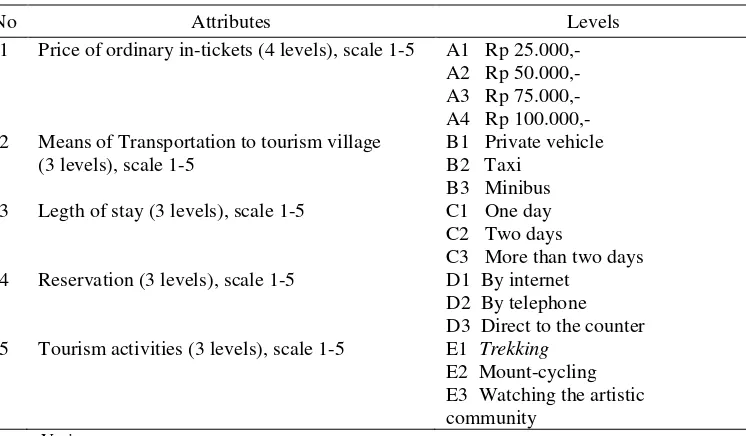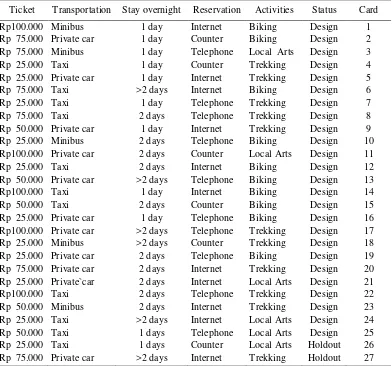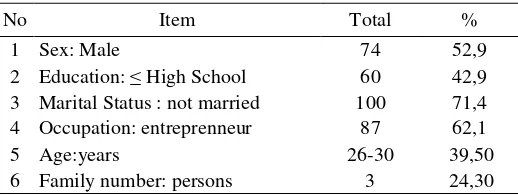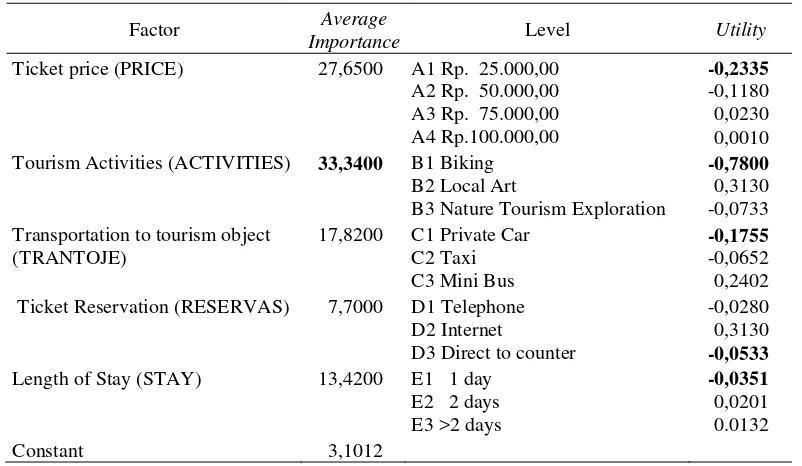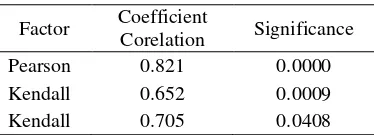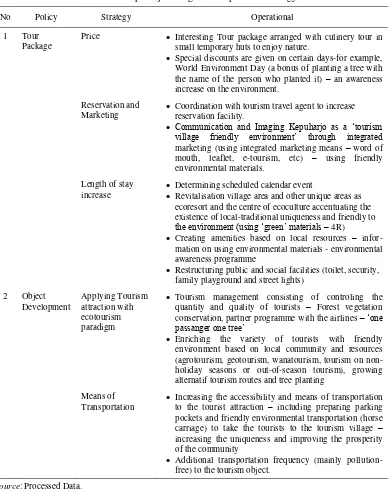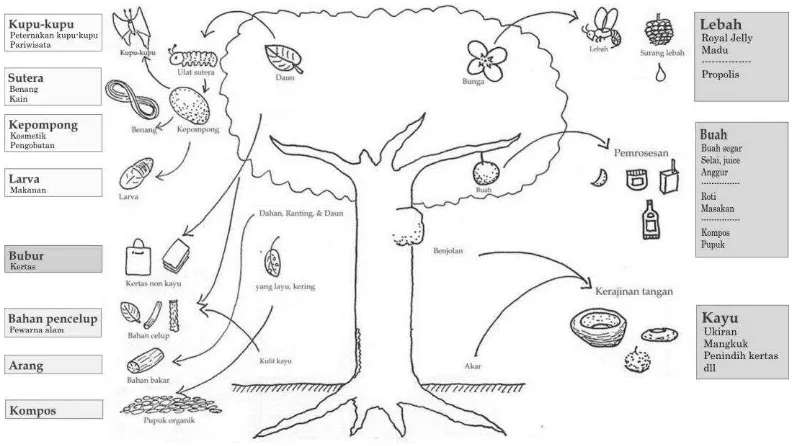Volume 24, Number 2, 2009, 205 – 220
THE STRATEGY OF RURAL TOURISM DEVELOPMENT
(An Eco-economy and Eco-cultural Approach)
Amiluhur Soeroso
STIE Pariwisata API, Yogyakarta (amisoeroso@gmail.com)
Y. Sri Susilo
Faculty of Economics Universitas Atma Jaya, Yogyakarta (yssusilo@gmail.com)
ABSTRACT
The research is aimed to analyse the strategy of rural tourism development in Kepuharjo, a village in the foot plain of Merapi Volcano. The data were obtained from 140 visitors doing activities surrounding Yogyakarta Special Province with structured questionnaire; the data was then analysed using conjoint analysis and analytic hierarchical process.
The finding shows that the strategy of rural tourism development of Kepuharjo village is called “saga”. Within this strategy, its urgent aspect is keeping an evergreen environment, where the object has to be a conservatory value that almost disappears of environmental change. Besides, it must enrich the attractions, improve quality of amenities and get better of accessibilities. The implication of the finding, sustainable development of rural tourism of Kepuharjo Village, should use both an eco-economy way (designed to mesh with Earth's ecosystem instead of disrupting and destroying it) and an eco-culture work (to respects the traditional knowledge of existence and supports local materials and biodiversity) simultaneously.
Keywords: strategy, rural tourism development, eco-economy, eco-culture.
INTRODUCTION
Kepuharjo is an 875 hectare village in the foot plain of Merapi Volcano. The village is located in Cangkringan, Sleman regency, around 30 minutes to the north of Yogyakarta. Besides its spectacular view, Merapi volcano is relatively cool with an average of 18˚-26˚C, as this area is located in an altitude of 540-1.200 meter height above sea level (dpal) with the amount of rainfall 2.000-3.000 mm per year (Susilo and Soeroso, 2007).
Kepuharjo village interests many investors who compete to build hotels, golf field, and
Based on those issues, there is a percep-tion that in developing and exploiting a region, there should be a balance between biogeo-physic and cultural aspects by paying attention to the ecosystem (Soeroso, 2007). The economic benefit that may be obtained from Kepuharjo village is not only in the form of recreation, spa in hotels or golfs but also in the form of its ecosystem utility. This potential is often not comprehensively measured as there are no values as indicators for its usage. This utility ecosystem which is passively shown by the awesome panorama with its people’s culture that inhibits it as a long-term living environment as a means of conservation. Frequently, this potential is not measured comprehensively as there is no value. Although sosial demands increase, if public does not interfere to guarantee this, thus its environmental function will probably disap-pear.
For that reason, in its ‘greenery’ develop -mental structure based on community, there is a comprehensive study on public management strategy and policy (Soeroso, 2007). A conservative policy in a sensitive area such as Kepuharjo needs an appropriate environmental management so that the failure of protecting the resource value for the next generation can be eliminated. Nevertheless, the effort of a living environmental conservation cannot ignore the participation of local community involved in their social arena where they interact. Based on the following condition, the aim of this study is to examine the strategy of the development of Kepuharjo Resort Village. LITERATURE REVIEW
Ecosystem
The ecosystem, an environmental living arrangement as a complete unity, influences to form a balance, stability and living environ-mental productivity (Article 1 Verse 4 UUPLH No. 23 year 1997). Its service is valued extrinsically and intrinsically (preser-vation, reservation for the next generation
importance), option (variety), culture (esthetics, art, education, spirituality, science) (Costanza, 1997: 388; Moons, 2003: 3).
An ecosystem contains a variety of good natural elements, either people’s culture or a mixture of both. The three are important resources that should be conserved so they become linked as mutual benefit with tourism industry (Wight, 1993:5). Thus, to have the environment appreciated, utilised and not destroyed, there should be some efforts to: (1) preserve, that is, prevent environmental degradation and maintain its conservation to be in a stable condition; and (2) conserve, that is, protect against the environment if considered having an important value either historical, architectural, cultural, etc.
Eco-economy
Continued developmental concept appeared twenty-five years ago, but not one country possesses a strategic economic development by guarding carbonic balance, population stability and together with forest conservation, soil and a variety of flora and fauna (Susilo & Soeroso, 2007). Only some successful countries make these one or two elements but none can make it satisfactorily. To return its nature balance once again is a big job to achieve. To decrease land erosion to its new formation level needs an agricultural change and it is not an easy task.
Eco-culture
Ecoculture is an integration between organisme with its environment and human beings. The aim is to improve the bad habit and behaviour in ecological management. The character of eco-culture is to choose the usage of energic source which is renewed, based on the believe that ecology and economy possess a living cycle which are glued to technology and the price including the technological impact towards the environment and its external (Gossen, 1993). Eco-culture pays attention on the existence of traditional knowledge and supports the usage of local raw materials.
Development
There are lots of sources valued with market price, however, most of them are imperfectly or incompletely valued, as their characters as a public possession that cannot be shared and are not exclusive, and are also limited information with that in the market (Susilo & Soeroso, 2007). For its nonefficient fee, the market works well by using a replacement from its source which generally exist, will reflect the real value from that market. Lots of sources in this world is prepared for only a small quantity, an absolute limitation or highly priced for its usage, so if there are an alocated mistake, it will cause economical and ecological problem.
Nevertheless, although there is limited source, human beings must often make a choice between guarding their environmental quality and economical development. In the case of tourism, the choice that has to be taken is between developing and not developing activity that links with it, or developing it with limitation to protect the exploitation of its source. The choice of non-economical development can preserve or conserve the source. Pearce (1993) said that preservation is equivalent to not include source, while conservation allows its usage by controlling its development.
Potpourri Strategy
The hierarchical policy, strategy and tactic are used in making decision towards the effort of management. The policy synthesizes the various optimal principles with public policy and legal process; or can mean as a deter-mination in designing to deal with social problems that exist until a proper action can be taken (Nagel, 1982: xiii).
For the time being, strategic management is an effort process to unite the plan and source possessed either by external or internal environment (Langabeer II, 1998). The aim is to achieve superiority and create safety position with efficiency, quality control, innovation and paying attention to consumers’ reaction; the target is developmental conser-vation (Lee & Snepenger, 1992: 48-49). However, tactic is part of the strategy to reach the target, that is, the continuous develop-mental cultural existency. On the tactic level, a cultural operational factor is chosen so as to possess competing energy. In the cultural development, the three are important as these sectors must pay attention to their balance. In order to have the aim and target of cultural management to achieve continually, in making redefinition, revitalisation and reposition strategy, the stakeholders’ involvement should be part of the decision making.
institution or target which is threatened by environmental change. Secondly, ‘Quests’ that focuses on the new era. The types of strategies are as follows: (a) new aim and long term target agenda; (b) grand vision towards city, area or institution; (c) long term alternative action to anticipate crisis or conflict.
Thirdly, ‘venture’, associated with (a) profit target on relativelt small chance; (b) trials, short term experiment capable of transaction with a various issues; (c) compacts, or short term agreement between institutions for an action and guarantees constraints together. Last of all, ‘parlays’, the effort to mitigate the high unexpected risk by presenting long term protection.The three strategies are: (a) hedging towards risks; (b) leveraging or engaging, the effort to negotiate to obtain excellence; (c) advancing, making short term response in important situations. RESEARCH METHOD
Sample
The sample representation depends on : (1) level of certainty needed, (2) the number of mistakes tolerated and (3) the number of
disperse in the estimated population (Palumbo, 1977: 279). According to Zikmund (1991: 510-511) the sample scale measurement can also be determined by the professional judge-ment of the researcher. There are some tech-niques to determine the sample measurement, one of them is according to Watson et al. (1993: 333-371) , the formula is as follows:
2 2½ 1
.
4 p p
n
(1)n is sample measurement, p is the successful proportion expected from sample, q is the remaining proportion (1-p), Z½ is the
confident coefficience, =L+R is the number of mistakes tolerated from the left side population rate (L) and right side (R). By assumption that p=90% and q=10%, =5% and Z½= 1,96; L=R=5% until =10%, thus according to the formula (1) the researcher determines sample as many as:
n = 4. (1,96)2. (0,9).(0,1)/(2.0,05)2 = 1,382976/0,01
= 138,2976 140 people.
Policy
Stra tegy
Ta ctics
1
2
Ventura
Saga Parlays
Antisipative
C
o
n
te
x
tu
a
l
C
h
a
n
g
e 1. Target
2. Tryout 3. Portofolio
1.New Agenda 2.Main Vision (goals) 3.Alternatives Qustion
1. Protection 2. Pry Up 3. Improvement
1.Restorative 2.Reformative 3.Protection
Disturbing
Short-Term Long-Term
Time Horizon
Source: Cappiello, et al. (1995: 5), Rubin (Bryson & Einsweiller, 1988)
Sample is taken by purposive on adult tourists above 17 years (Kuncoro, 2003). Assuming that they have permanent income, and for each family or group 1 sample is taken as a respondent. The place sample taken is in Kepuharjo Village and also in hotels/motels, airport, railway stations or other places visited by tourists in Yogyakarta.
Management Strategy
To measure consumers’ preference, a method is used to illustrate the consumers’ realistic determination as a trade-off among the various product attributes. For this pur-pose, a conjoint is used to know the consumers’ preference on potential products and evaluate the combination of determined attributes. The linkage process (to predict the consumers’ choice towards certain product formulation) starting from the combined making of independent variable value until evaluating simulator chosen is done with softwares (Hair et al., 2006).
The first step in analyzing conjoint is by (1) relevant attribute choice; in this study five attributes are determined, those are; price, means of transportation, length of stay, reser-vation and tourism activities; (2) indentify attributes by relevant level. The number of attributes levels is determined as many as 16 levels, thus, theoretically will obtain 324 stimuli (4 x 34), which have to be scored by the respondents (Table 1).
To make the number of combined attribute profile more efficient and not tiring for the respondents, an orthogonal design procedure is used, which is a conjoint stimuli procedure used for generalize a great number of combined attributes to become realistic number to score respondent (Hair et al., 2006). Besides that, in making stimuli, two holdouts were determined (stimuli validation) for a result test obtained, to know whether the sample usage is synchroned in the conjoint process to population. From the software execution result, it is obtained twenty five stimuli and two holdouts. Twenty seven Table 1. List of Attributes and their Levels
No Attributes Levels
1 Price of ordinary in-tickets (4 levels), scale 1-5 A1 Rp 25.000,- A2 Rp 50.000,- A3 Rp 75.000,- A4 Rp 100.000,- 2 Means of Transportation to tourism village
(3 levels), scale 1-5
B1 Private vehicle B2 Taxi
B3 Minibus 3 Legth of stay (3 levels), scale 1-5 C1 One day C2 Two days
C3 More than two days 4 Reservation (3 levels), scale 1-5 D1 By internet
D2 By telephone D3 Direct to the counter 5 Tourism activities (3 levels), scale 1-5 E1 Trekking
E2 Mount-cycling E3 Watching the artistic community
combined attributes are then presented to respondents to be scored with a scale of 1-5 starting from the highest until the lowest (Cooper & Schindler, 2001) each according to its preference (Table 2).
The follow up is to measure the attributes and their important levels in the tourism packet choice determination to Kepulharjo Village by using proportional level between maximum and minimum usage level for each attribute (Hu & Hiemstra, 1996). The most important attribute that reflexes the real
important result is as follows:
Wj=
%) ( Min ) ( Max
) ( Min ) ( Max
J
j
ij ij
ij ij
V
V
V
V
100
1
(4)
Wj is the relative importance from
attribute j (j = 1, J); Max (Vij) is the maximum
usage level i in attribute j (i ≤ I) while Min (Vij) is the minimum i usage level in attribute j
(i ≤ I). To know the important attribute from the consumers in the tourism packet choice
Table 2. Stimuli Design
Ticket Transportation Stay overnight Reservation Activities Status Card
Rp100.000 Minibus 1 day Internet Biking Design 1
Rp 75.000 Private car 1 day Counter Biking Design 2 Rp 75.000 Minibus 1 day Telephone Local Arts Design 3
Rp 25.000 Taxi 1 day Counter Trekking Design 4
Rp 25.000 Private car 1 day Internet Trekking Design 5 Rp 75.000 Taxi >2 days Internet Biking Design 6 Rp 25.000 Taxi 1 day Telephone Trekking Design 7 Rp 75.000 Taxi 2 days Telephone Trekking Design 8 Rp 50.000 Private car 1 day Internet Trekking Design 9 Rp 25.000 Minibus 2 days Telephone Biking Design 10 Rp100.000 Private car 2 days Counter Local Arts Design 11
Rp 25.000 Taxi 2 days Internet Biking Design 12
Rp 50.000 Private car >2 days Telephone Biking Design 13
Rp100.000 Taxi 1 day Internet Biking Design 14
Rp 50.000 Taxi 2 days Counter Biking Design 15
determination in Kepuharjo Village can be seen through the column of importance, that is, the column that consists of the percentage value of importance for each attribute according to respondents’ view as a whole (Santoso, 2002: 280).
Next, based on the analised result, policy, strategy and tactic for developmental ope-ration is arranged and confirmed with 15 experts. Finally, an anlitical hirarchical pro-cess is done (PHA) by using software expert choice to decide its priority. PHA is a priority measurement based on ratio scale developed by Saaty (1986). Besides using measureing scala, AHP uses basic scale on relative level starting from 1 until 9 (Kintarso & Peniwati, 2001). Through this method the decisionmaker can utilize the expertise knowledge to obtain a logical information which is arranged in the hirarchy.
RESULT AND DISCUSSION
Research Object and Respondents’ Profile Tourists who visit Kepuharjo Village fluctuatively, by domestic domination towards foreign countries in the last five years (Table 3). Kepulharjo Village has some attractions
that interest tourists. Besides natural tourism such as Merapi Golf, Kali Kuning Forest, Kaliadem, trekking, lava tour to Merapi Volcano, biking and camping ground in the Valley of Kali Kuning River, also cultural attractions as labuhan Merapi.
Tourists who became research respon-dents were mainly men (52.9%), high school graduates(42.9%), not married(71.4%), entre-prenneurs (62.1%), age 26-30 years. This shows that the respondents are still in their productive age (Table 4).
The social-economic characteristic (occu-pation and education) and demography (gender and age) tourists influence the type of tourism. The higher the social-economic tourists, the more exotic and friendlier the environment is needed as a tourism product (Searle dan Jackson, 1985; Boo dalam Luzar et al., 1998: 51). The difference of sex (gender) and age of tourists have a variety of time to spend their leisure time, while the tourists’ original place possess a different attitude and behaviour towards the tourists product needs until it often needs a certain sosialised process (Henderson et al., 1988). Men usually choose a tour that will spend
Table 3. Data of Visitors
Tourists 2002 2003 2004 2005 2006
Foreign 2.652 205 2.663 2.609 2.108
Domestic 93.765 92.324 120.888 133.833 113.584
Total 96.417 92.529 123.551 136.442 115.692
Source: Culture and Tourism Department, Sleman (2007), processed data
Table 4. Respondents’ Profile
No Item Total %
1 Sex: Male 74 52,9
2 Education: ≤ High School 60 42,9 3 Marital Status : not married 100 71,4 4 Occupation: entreprenneur 87 62,1
5 Age:years 26-30 39,50
plenty of adrenalin such as trekking, mountain climbing, golf etc., while for family size often becomes a commitment constraint to do recreational activities (Searle and Jackson, 1985). However, it appears here that family size is normative for Indonesian measurement. Consumers’ Preference on Products
The result of the data management with conjoint analysis method (Table 5) shows that subfile summary brings forward an average importance to each factor or object of tourism attributes of Kepuharjo Village. Following this, the utility column consisting of 140 respondents’ opinions as a whole on each level of factors or object attribute. In principle, utility is the difference between value factor and constant, with a distance of 1 score (very much liked) until 5 (not liked). While constant, theoretically (in this research 3,1012) is a number as a basic to find the utility scale from the price ticket factor, tourism activities, transportation leading to tourism object, reservation and the length of stay.
Next, the resulting interpretation also-shows, firstly, on price ticket, utility column show 2 levels possessing negative values, those are, A1 (Rp.25.000,00) and A2 (Rp.50.000,00), meaning that generally the respondents view that both price level tickets are reasonable. However, from the greater value of utility, A1 (Rp.25.000,00) has a bigger value, that is -0.233 meaning that respondents’ preference choose ticket price of Rp.25.000,00 to enter Kepuharjo area according to the obtained ticket.
Secondly, tourism activitiy factor has the biggest important value range (33.34) so that it shows that this factor is the most important one for a tourist in choosing the tourism object Kepuharjo Village as a target tourism. On the column with tourism activities factor, B1 (biking) and B3 (nature tour exploration) possess a negative utility value, that shows respondents’ preference on that activity. Between the two, the respondents prefer B1 (biking tour).
Table 5. Result of Conjoint Analysis
Factor Average
Importance Level Utility
Ticket price (PRICE) 27,6500 A1 Rp. 25.000,00 A2 Rp. 50.000,00 A3 Rp. 75.000,00 A4 Rp.100.000,00
-0,2335 -0,1180 0,0230 0,0010 Tourism Activities (ACTIVITIES) 33,3400 B1 Biking
B2 Local Art
B3 Nature Tourism Exploration
-0,7800 0,3130 -0,0733 Transportation to tourism object
(TRANTOJE)
17,8200 C1 Private Car C2 Taxi C3 Mini Bus
-0,1755 -0,0652 0,2402 Ticket Reservation (RESERVAS) 7,7000 D1 Telephone
D2 Internet
D3 Direct to counter
-0,0280 0,3130 -0,0533 Length of Stay (STAY) 13,4200 E1 1 day
E2 2 days E3 >2 days
-0,0351 0,0201 0.0132
Constant 3,1012
Thirdly, on transportation factor which is used to reach the tourism place, two levels on utility column are seen possessing negative values, those are, C1 (private car) and C2 (taxi), with a chosen value on C1 (private car) totalling -0.1755.
Fourthly, the way to make reservation has two levels which are preferred by the consumers, each D1 (using telephone) and D3 (to the counter). Both possessing negative utility values (-0.0280 and -0.0533) with the consumers’ preference of choosing reservation more by going to the object and buying the ticket in the counter.
Finally, the length of stay factor is only E1 (stay 1 day) possessing negative utility value, generally the respondents prefer to stay and enjoy the tour not more than a day.
Following that, to know the most important determined attribute for a tourist in choosing a tourist resort as Kepuharjo village as a tour aim, can be seen on average importance column (Table 6) that contains the percentage value of the important level of each factor or research attribute according to respondents’ view as a whole. The sequence of average importance of each factor or attribute starting from the biggest percentage of value until the smallest: (1) tourism activities (33.34%), (2) ticket price (27.65%), (3) trans-portation to the tourist resort (17.82%), (4) length of stay (13.42%) and (5) reservation (7.77%).
Table 6. The Result of Pearson and Kendall Corelation
Factor Coefficient
Corelation Significance
Pearson 0.821 0.0000
Kendall 0.652 0.0009
Kendall 0.705 0.0408
Source: Data Management (2007)
To predict the pattern of respondents’ opinion, an estimated path-worth is utilised and comparing the result with the respondents’
actual opinion from the stimulated process. Predictive accuracy measurement is done to measure the level of predictive accuracy which appears from the high coorelation and significance between estimates with actual result. Predictive accuracy is measured by analyzing the coorelated value of Pearson and Kendall which is obtained directly from the analysis.
The result obtained shows that the coore-lated value of Pearson and Kendall possess positive value, significant with a certainty degree of 95 percent. This shows that there is a strong relation between estimates result and actual result. In other words, conjoint analysis done possess a high predictive accuracy until 140 respondents who became samples in the research can illustrate the tourists needs on Kepuharjo object resort as a tourism target. Developmental Strategy
By referring to Figure 1-B, the time horizon needed to change the developmental behaviour that takes a long time focusing on its context is by eliminating constraints. For that reason, a ‘Saga’ strategy is needed by suppressing the ‘protective’ ecosystem function. Later, referring to the conjoint analysis result, thus the developmental policy of Kepuharjo Village referring to the ecotourism related to tourism packet and developmental object. For this reason, the segment is focused on the ecotourists. The tourism packet strategy is on the price determination, reservation facility and length of stay increase, while the developmental object is based on the local community development (Table 7).
if the tourists take this Kepuharjo Village tour packet) and also special discounts can be given to tourits on certain days (for example on the Indonesian Independence day, World
Environment Day). Besides that they are given additional incentive, joining the reforestation programme by signing their names on the board attached to the planted trees there. This
Table 7. Kepuharjo Village Developmental Strategy
No Policy Strategy Operational
1 Tour Package
Price Interesting Tour package arranged with culinery tour in small temporary huts to enjoy nature.
Special discounts are given on certain days-for example, World Environment Day (a bonus of planting a tree with the name of the person who planted it) – an awareness increase on the environment.
Reservation and Marketing
Coordination with tourism travel agent to increase reservation facility.
Communication and Imaging Kepuharjo as a ‘tourism village friendly environment’ through integrated
marketing (using integrated marketing means – word of mouth, leaflet, e-tourism, etc) – using friendly environmental materials.
Length of stay increase
Determining scheduled calendar event
Revitalisation village area and other unique areas as ecoresort and the centre of ecoculture accentuating the existence of local-traditional uniqueness and friendly to
the environment (using ‘green’ materials – 4R)
Creating amenities based on local resources – infor-mation on using environmental materials - environmental awareness programme
Restructuring public and social facilities (toilet, security, family playground and street lights)
2 Object Development
Applying Tourism attraction with ecotourism paradigm
Tourism management consisting of controling the quantity and quality of tourists – Forest vegetation conservation, partner programme with the airlines –‘one
passanger one tree’
Enriching the variety of tourists with friendly environment based on local community and resources (agrotourism, geotourism, wanatourism, tourism on non-holiday seasons or out-of-season tourism), growing alternatif tourism routes and tree planting
Means of Transportation
Increasing the accessibility and means of transportation to the tourist attraction – including preparing parking pockets and friendly environmental transportation (horse carriage) to take the tourists to the tourism village – increasing the uniqueness and improving the prosperity of the community
Additional transportation frequency (mainly pollution-free) to the tourism object.
programme is to support their awareness on the environment.
In the reservation part, marketing is included; by coordinating with tourism travel agents to increase the reservation facility. From the conjoint analysis, it can be noticed that the tourists preference to reserve directly is not yet their habit to use on-line facility through internet website. Communication means and integrated image (integrated marketing means usage such as word of mouth, leaflet, e-tourism, magazines etc) by positioning Kepuharjo as a ‘green’ tourism village. Advertisements using friendly envi-ronmental materials, like using recycled papers. Word of mouth marketing is considered an effective and cheap means.
To increase the length of stay of the tourists, there should a scheduled event calender determination, revitalize the unique area of the village as an ecoresort and the centre of ecoculture focusing on the existence and activities that have a local-traditional uniqueness such as festivals, competitions or other events that can motivate the communi-ties’ interest to preserve the properties, art, rituals, spirituals, food and traditional crafts. Here, what is shown is that friendly towards the environment is not only to the abiotic physical elements (vegetation, land, panora-ma) but also to human organism living around them as biotic elements and His cultural creation and wish.
The tourists are presented a product full of friendly environment (eco-responsible), focusing on ‘4R’, those are, reduce, reuse, recycle and rethinking, either the system, procedure or policy. Such as the efficiency of the benefit of water, recycling grey water, consecrete mountain sides so as not to slide biotechnically (bioengineering) using bamboo plants (Ponatherum paniceum) and Citronella (Andropogon nardus) grass that can cover the mountain sides and prevent slides on oblique field or caliandra (Caliandra callotrisus), and avoiding massive pieces of concrete so that it
wont blocked the water resource around. Besides becoming the communities’ forest and terrace strength, the plants are capable of supporting the economy at difficult times.
Tourism amenities are seeked using products based on local resources including having talkshows on the utilisation of friendly environmental materials which exist around the area by making use of the various types of plant remnants such as stem of banana leaves, leaves, branches, flowers and other parts of plants like Larasetu (Vertiver zizanoides), Keladi Tikus (Hyponium flagelliforme), Kapuk randu (Bombax malabaricum), jackfruit (Arthocarpus intergra), pineapple (Ananas comosus), longbeans (Arachis hypogaea), Banana (Musa Sp.) etc that all this time are only thrown for they are considered not beneficial. These things are useful to make various products, starting from soap, candles, oil, perfume, beverages such as tea and wine, jam etc which are used in the resort, hotels and for souvenirs.
Various trees that grow in this area (Figure 2), other than being harvested as fresh fruit that can become jam, wine and fertilizer from materials are no longer useful such as leaves, branches, stems and their dried roots. It can still be created into new products that have additional value. Other products are charcoal, compost, paper mixture from leaves and colored materials from wood skin. From imported materials, such as: (1) bees pro-ducing honey, royal jelly, propolis (a sort of cementlike or reddish fillings which are collected by bees from tips of plants) are usefull to strengthen body cells and (2) butterflies producing coccoons which can be processed to become silk thread, cosmetics and medicine. Their larvas are processed to become food. Besides the friendly environ-ment, these products can increase the commu-nities’ income and at the same time become amenities that interest the tourists.
which is far greater if it is left growing compared to being cut off. The cutting of trees will only be useful in the obscure short-term, because the negative externality which appear are like land erosion, decrease of landwater stock until the emission of carbon to the atmosphere are never calculated. During this time the economical usefulness value of vegetation is hidden. For that reason, besides the presentation of tourism awareness programme, there is also a need to campaign environmental awareness to the community..
To increase the tourists’ length of stay, there is a need to improve public and social facilities (Public toilets, family playground, street lights, security etc). For the time being, the result of conjoint analysis shows that respondents’ preference to cultural objects are low, and this is probably due to the role of cultural resource in this area is not yet prominent in tourism. Tourist attraction which is shown should present a combination between natural and cultural resource of that place: such as, biking, and trekking while
leading it to see the local culture (dances, stories, floklore etc) along the streets which are passed through by the tourists.
The processed attraction management must be based upon ecotourism that aims to conserve living environment. Besides con-trolling the quantity and increasing the quality of the tourists, it also create a variety of unique tourist attraction based on the local community and resource. These are known for their mushroom centre, coconut sugar, jackfruit, banana, durian, mangosteen and avocado which can be developed as agrotourism and wanatourism. Nevertheless, the point is not only to ask tourists to go around picking fruits or to see the beauty of nature but also to support their collaboration with the commu-nity to appreciate various vegetation that can be a shade and protect the ecological system (ecosystem) there.
Grieg-Gran (2006) said that the result of forest land conversion becoming farming land,includes the process of wood sale which is equivalent to US$1-5 per ton of CO2, while Source: Kuroda (2004), Soeroso (2007)
the price of reforestation reaches US$30 per ton of CO2. For the time being for each hectare of forest land, if it becomes a field will produce NPV (net oresent value) US$2, soybean agriculture (Glycine max) producing US$1.000, and if the wood of the trees are sold will give US$236-1035. Nevertheless, if the forest is left alone, it is predicted that per hectare can preserve until 500 tons of CO2 with the price of US$35-50 per ton, thus producing US$17.500-25.000 (Stern, 2006).
Other programme that can be done is by being partners will give profit, for example, by using airlines like Garuda Indonesia which offer ‘one passenger one tree’ programme to make the marginal area green, located on the height of one thousand hills, in Karang Tengah, Bantul District. The concept is by setting aside part of the ticket price paid by the passengers becoming vegetation planted by themselves in places already decided. Simbiosis mutualistis such as this one will give the community lots of benefit from the tourists who visit by Garuda Indonesia and planted trees for greenery, while the airlines receive benefit from the consumers’ acknowledgement that they are from the flight service that ‘cares about the environment’.
The development of other tourism is by supporting the tourists on out-of-season tourism and add other alternative tourism route. Historical tourism can be linked with the development of Kepuharjo Village concerning the objects of Watu Gajah, Watu Tumpeng and Goa Jepang. Close to that area, along the bank of Gendol River, there are thousands of long-tailed monkeys (Macaca fascicularis) which can become of interest for tourism. Concerning geotourism can be done to stones and the features of Gunung Merapi, earthquake division, lava tour etc.
The means of transportation is needed to increase the accessability and types of transportation (those with friendly environ-ment) and the frequency of going to the tourism object. There should be a place to put
the parking pockets for vehicles with fossil fuel on a rather distanced place to reach the tourism village. The tourists ride on ox or horse carriage. This policy is not only on the increasing uniqueness of the tourism village but also on the improving of the communities’ properous life. Nevertheless, this cannot possi-bly be done without the participation of the community and partnership with the investors. Management Priority
As discussed earlier about developmental strategy, the priority of developing the management of Kepuharjo as a Tourism Village was based on the euphoria of green product. Later, to decide the management determination as a whole a hierarchical analy-tical process (PHA) was used by determining the priority between elements, synthesizing consideration (scoring), studying on the consistency of the consideration and deciding the last part based on results of this process. By taking advantage of experts’ judgment helped by Expert Choice software, the result can be seen through Figure 3 and Figure 4.
In Figure 3 shows that the index of probability which is not-consistent is 0,03 (p<0,10) so that it can be proposed that the development design model can be appro-priately utilised. Figure 4 shows the result of the development of the sensitivity strategy analysis. The priority of the development includes tourist attraction in enrichment, followed by tourism management, the price per packet is arranged with culinery tourism, integrated marketing, revitalizing the village are as eco-resort and eco-culture, increasing the transportation frequency to the object, increasing accessabilities, creating amenities from local materials, and giving special discount prices on certain events.
Discussion: Economical Development and Natural Conservation
as vegatation (Figure 2) and local cultural re-source thus developmental strategy Kepuharjo as a Tourist Village focusing on the compre-hensive development not on the economical growth. Economical growth is an increase of economical capacity, and happens if the thing and resource enjoyed by human or not grow faster than the population compared to. While community health improvement, increase of artistic equipments, safety and a number of product difficult to quantify (includes the benefit of vegetation conservation) is most of the economical growth (Van & Berg, 2005). The growth itself is aimed to increase output. On the contrary the development is more vastly aimed by changing it wholly not only economical but also on sociocultural management resulting output changes.
Hence, it must be realised that continuous growth is not possible, but continuous economical growth can be achieved if func-tional eco-system balance is endured according to the local character and wisdom. Conservation is not focused enough on the land or physical article, but it should be integrated by paying attention to its eco-culture network, that is, the relation between bio-geophysic element and cultural or people who live there.
Actually, what can be done is the effort to safe the forest or vegetation in Kepuharjo area by adopting REDD (Reducing Emission from Deforestation in Developing Countries) programme, that is, the mechanism of giving insentive funding from industrial countries to developing countries the forest owner to prevent the forest’s distruction, conservation and increase of carbon stock in developed countries. This programme is hoped to follow eliminating global warming, that is, besides it is useful to help increase the land’s fertility naturally and isolate Carbon, it can also decrease the need of chemical fertilizer, deforestation and increase the quality of water (Stern, 2006).
Besides through the tourism programme, the community are supported to preserve the forest or plants through reforestation, affore-station (defend vegetation which is planted through reforestation) and soil carbon offset (with grass conservation and plantation). The result can be utilised to buy Carbon Financial Instrument. Girling (2005) viewed that the Nhambita in Mozambik, changed marginal land becoming a forest that stored 90 tons of CO2 per hectare. This result was then used to buy Carbon Neutral Company.
CONCLUSIONS
The conclusion of this research is that the development of Kepuharjo as a tourism village should utilize the ‘saga’ strategy. This means, to place this village as protection place for the value, uniqueness or other resources which is threatened to disappear because of the pre-sence of an environmental change. So, there is a need to respon this situation by creating uniqueness based on the present local resources, those are, beauty and environmental art.
canopy, hence it can become an tourism attraction that interest holiday-makers. A programme to replant vegetation can be linked with trekking, agrotourism, wanatourism even geotourism. Other economical effect that can be enjoeyd by the local community from eco-tourism and forest management programme by the community (PHOM) is the secured micro season and Carbon stock which is preserved can be used for transaction.
Secondly, the tourists are interested in buying tourism packets if the tourist attraction offer unique nuances. For the time being, the uniquesness of Kepuharjo area is actually prepared by natural richness collaboration and local community’s culture until told to explore it might become an attraction and friendly environmental amenities which are raved by holidays-makers. While accessabilities present is increased and designed with a means of free pollution that give benefit to the community.
For that purpose, the effort of economical growth must be integral with living environ-mental eco-system conservation, knowldge and traditional life of man’s culture involved in it (eco-culture). Tourism richness attraction, tourism management, orderly priced and culiner tourism should be integrated by revitalizing village area around it, to be made eco-resot and eco-culture with inhibiting accent which is glued to nature by spreading the benefit of vegetation existence based on traditional knowledge and the the use of local potential. Presenting tourism attraction should be dug from the variety of local community’s cultural resource such as dances, stories and folklores. If this is done, the ABC (abiotic, biotic and cultural) element interaction of the living environment can support the success of the tourism village strategy.
REFERENCES
Bryson, J.M. and R.C. Einsweiller, 1988. Strategic Planning: Threats and Opportu-nities for Planners. Chicago: Planners Press.
Cappiello, S., M. Freed., M. Jacobsen., and J. Taylor, 1995. A Product Launch Strategy for Kid Science. Paper presented in EES 283.
Cooper, D.R., and P.S. Schindler, 2001. Busi-ness Research Methods. 7th Ed. New York: The McGraw-Hill Companies, Inc. Costanza, R. 1997. ‘The Value of The World’s
Ecosystem Services a Natural Capital’. Nature, 387-395.
Dinas Kebudayaan dan Pariwisata Kabupaten Sleman, 2007. Data Pengunjung Obyek Wisata di Kabupaten Sleman, Daerah Istimewa Yogyakarta [Data of Visitor List in Sleman Tourist Area]. Sleman, Yogyakarta: Department of Cultural and Tourism Sleman Regency.
Girling, R., 2005. “We’re Having a Party”. Sunday Times Magazine.
Gossen, C., 1993. Ecoculture and Survival: Sustainability vs. Habit & Behavior Sus-tainable Structures. Portland, Oregon: Unpublished document.
Grieg-Gran, M, 2006. The Cost of Avoiding Deforestation. Report Prepared for Stern Review, International Institue for Envi-ronment and Development.
Hair, J.F., Jr., R.E. Anderson. R.L. Tatham. and W.C. Black, 2006. Multivariate Data Analysis. 6th ed. NJ, USA: Prentice Hall, Inc.
Hu, C. and S. J. Hiemstra, 1996. ‘Hybrid Conjoint Analysis as a Technique to Measure Meeting Planners Preferences in Hotel Selection. Journal of Travel Research, 35 (2).
Kuncoro, M, 2003. Metode Riset Untuk Bisnis & Ekonomi: Bagaimana Meneliti & Menulis Tesis [Research Methodology for Economy & Business: How To Do Research & Write a Thesis]. 1st Print. Jakarta: Erlangga.
Kuroda, M, 2004. Application of Productivity and Management Tools for OVOP, Utilisation of Unused Resources and by-Products: Case study of Indonesia Wild Silk Development Project. Paper of Seminar on the “One Village – One Product” Movement for Community Development. Chiang Mai, Vietnam. Langabeer II, J, 1998. ‘Competitive Strategy
in Turbulent Healthcare Markets: An Analysis of Financially Effective Teaching Hospitals’. Journal of Healthcare Management, 43 (6), 512-526. Lee, D.N.B. and D.J. Snepenger, 1992. ‘An Ecotourism Assessment of Tortuguero, Costa Rica’. Annals of Tourism Research, 19 (2), 1367-370.
Luzar, E.J., A. Diagne., C.E. Gan., and B.R. Henning, 1998. ‘Profilling The Nature-Based Tourist: A Multinomial Logit Approach’. Journal of Travel Research, 37, 48-55.
Moons, E, 2003. The Development and Appli-cation of Economic Valuation Techniques and Their Use in Environmental Policy: A survey. Belgium: Energy, Transport and Environment, Center for Economic Studies, Katholieke Universiteit Leuven. Nagel, S.S. 1982. Policy Evaluation: Making
Optimum Decisions. New York, USA: Praeger Publisher.
Palumbo, D.J, 1977. Statistics in Political and Behavioral Science. (Rev Ed). NY, USA: Colombia University Press.
Pearce, D.W, 1993. Economic Value and the Natural World. Massachusetts: MIT Press.Cambridge.
Saaty, T.L, 1986. Decision Making for Lea-ders: The Analytical Hierarchy Process for Decisions in Complex World. Pittsburgh, USA: University of Pittsburgh. Santoso, S, 2002. Buku Latihan SPSS Statistik
Multivariat [SPSS Multivariate Statistic Exercise Book]. Jakarta: PT. Elex Media Komputindo.
Soeroso, A, 2007. Penilaian Kawasan Boro-budur dalam Kerangka Multiatribut Ekonomi Lingkungan dan Implikasinya terhadap Kebijakan Ekowisata [Borobudur Area Valuation in Ecological Economy Multiattribute Paradigm and its Implication on Ecotourism Policy]. Disertation. Post-Graduated Programme Yogyakarta: UGM (not to be pulished). Sri Susilo, Y., dan A. Soeroso, 2007. Nilai
Ekonomi dan Strategi Pengembangan Desa Wisata di Propinsi Daerah Istimewa Yogyakarta [Economy Value and Development Strategy of Village-Tourism in Yogyakarta Province], Research Report. Yogyakarta: Atma Jaya University (not to be published).
Stern, N, 2006. The Economic of Climate Change: The Stern Review. Cambridge, UK: Cambridge University Press. Undang-undang RI Nomor 23, 1997.
Pengelo-laan Lingkungan Hidup [Management Ecology Constitution].
Van den Berg, H, 2005. Economic Growth and Development. Singapore: McGraw-Hill Irwin.
Watson, C.J., P. Ballingsley., D.J Croft., and D.V. Hundsberger, 1993. Statistic for Management and Economics. NJ, USA: Prentice Hall, Inc.Englewood, Cliffs. Wight, P, 1993. ‘Ecotourism: Ethics or
eco-sell?’. Journal of Travel Research, 31, 3-9.

